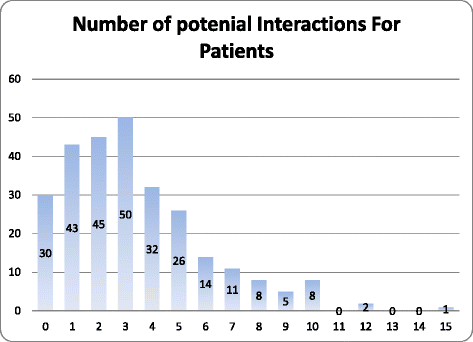Evaluation of potential drug- drug interactions among Palestinian hemodialysis patients
- PMID: 27456700
- PMCID: PMC4960860
- DOI: 10.1186/s12882-016-0317-4
Evaluation of potential drug- drug interactions among Palestinian hemodialysis patients
Abstract
Background: The aims of this study are to find the prevalence of potential drug-drug interactions (DDIs) in patients with Hemodialysis and identify factors associated with these interactions if present.
Methods: The study was an observational- retrospective cohort study that was conducted in ten hemodialysis units in the West bank, Palestine, between June and August 2015. The data collection form was completed by interviewing the patients in addition to reviewing their medical records. Potential DDIs were reviewed. SPSS program was used for data analysis.
Results: The study included 275 patients, a total of 930 potential interactions were identified in 245 (89.1 %) patients. Patients were prescribed 1-15 drugs with a mean (± SD) of 7.87 ± 2.44, calcium carbonate was the most common drug prescribed. The most common potential interaction in 114 (41.5 %) patients was Calcium Carbonate/Amlodipine followed by Calcium Carbonate/Aspirin in 76 (27.6 %) cases. Most patients (89.9 %) of the patients had one or more comorbid diseases; hypertension, diabetes and gout were the most common. Univariate analysis showed that the number of potential DDIs were related to the number of diseases, the number of prescribed drugs (P value <0.0001) and the age of the patient (P value = 0.015). The results of multiple linear regression showed a significant positive association between number of potential DDIs with the total number of medications (r = 0.242; p < 0.001).
Conclusion: The prevalence of potential drug- drug interactions among hemodialysis patients is very common; they are highly expected and depend on the number of drugs taken by the patients. Many of these potential interactions are considered as preventable drug- related problems, so screening for potential interactions and monitoring regularly is highly needed.
Keywords: Drug-drug interactions; Hemodialysis; Palestine.
Figures
Similar articles
-
Prevalence and pattern of potential drug-drug interactions among chronic kidney disease patients in south-western Nigeria.Niger Postgrad Med J. 2017 Apr-Jun;24(2):88-92. doi: 10.4103/npmj.npmj_64_17. Niger Postgrad Med J. 2017. PMID: 28762362
-
Comorbidity, Polytherapy, and Drug Interactions in a Neurological Context: An Example of a Multidisciplinary Approach to Promote the Rational Use of Drugs.J Pharm Pract. 2018 Feb;31(1):58-65. doi: 10.1177/0897190017699138. Epub 2017 Mar 21. J Pharm Pract. 2018. PMID: 29278992
-
Prevalence of the coprescription of clinically important interacting drug combinations involving oral anticancer agents in Singapore: a retrospective database study.Clin Ther. 2012 Aug;34(8):1696-704. doi: 10.1016/j.clinthera.2012.06.025. Epub 2012 Jul 15. Clin Ther. 2012. PMID: 22795926
-
Nephrology Update: End-Stage Renal Disease and Renal Replacement Therapy.FP Essent. 2016 May;444:23-9. FP Essent. 2016. PMID: 27163762 Review.
-
Drug-drug interactions in polypharmacy patients: The impact of renal impairment.Curr Res Pharmacol Drug Discov. 2021 Mar 29;2:100020. doi: 10.1016/j.crphar.2021.100020. eCollection 2021. Curr Res Pharmacol Drug Discov. 2021. PMID: 34909655 Free PMC article. Review.
Cited by
-
A retrospective evaluation of drug-drug interactions in patients admitted to Internal Medicine Departments in Palestinian Hospitals.SAGE Open Med. 2022 Nov 21;10:20503121221138488. doi: 10.1177/20503121221138488. eCollection 2022. SAGE Open Med. 2022. PMID: 36451776 Free PMC article.
-
Assessing the efficacy and safety of Juan Bi Tang for dialysis-related myofascial pain in the fistula arm: Study protocol for a randomized cross-over trial.Front Public Health. 2022 Aug 19;10:925232. doi: 10.3389/fpubh.2022.925232. eCollection 2022. Front Public Health. 2022. PMID: 36062127 Free PMC article.
-
Prevalence of Potential Drug-Drug Interaction Risk among Chronic Kidney Disease Patients in a Spanish Hospital.Pharmaceutics. 2020 Jul 30;12(8):713. doi: 10.3390/pharmaceutics12080713. Pharmaceutics. 2020. PMID: 32751436 Free PMC article.
-
Binding interactions with sevelamer and polystyrene sulfonate in vitro.Pharmacol Res Perspect. 2021 Aug;9(4):e00834. doi: 10.1002/prp2.834. Pharmacol Res Perspect. 2021. PMID: 34302439 Free PMC article.
-
Clinical Pertinence and Determinants of Potential Drug-Drug Interactions in Chronic Kidney Disease Patients: A Cross-sectional Study.J Pharm Technol. 2024 Jun;40(3):142-151. doi: 10.1177/87551225241241977. Epub 2024 Apr 3. J Pharm Technol. 2024. PMID: 38784027
References
-
- Levey AS, Eckardt KU, Tsukamoto Y, Levin A, Coresh J, Rossert J, De Zeeuw D, Hostetter TH, Lameire N, Eknoyan G. Definition and classification of chronic kidney disease: a position statement from Kidney Disease: Improving Global Outcomes (KDIGO) Kidney Int. 2005;67(6):2089–100. doi: 10.1111/j.1523-1755.2005.00365.x. - DOI - PubMed
-
- Wen CP, Cheng TY, Tsai MK, Chang YC, Chan HT, Tsai SP, Chiang PH, Hsu CC, Sung PK, Hsu YH, et al. All-cause mortality attributable to chronic kidney disease: a prospective cohort study based on 462 293 adults in Taiwan. Lancet. 2008;371(9631):2173–82. doi: 10.1016/S0140-6736(08)60952-6. - DOI - PubMed
Publication types
MeSH terms
Substances
LinkOut - more resources
Full Text Sources
Other Literature Sources
Medical


